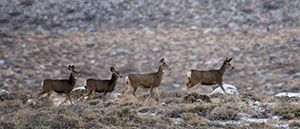New UW Study Finds Surface Disturbance Can Limit Mule Deer Migration
Published June 09, 2020

A new study shows that surface disturbance from energy development can hinder mule deer migrations when it exceeds 3 percent.
Researchers from the University of Wyoming and Western Ecosystems Technology used 15 years of movement data collected from GPS-collared mule deer in western Wyoming to evaluate how much disturbance mule deer could withstand during migration. The study was conducted in the Pinedale Anticline -- the sixth-largest natural gas field in the nation and home to one of the largest deer herds in the West.
The findings were published in the Journal of Wildlife Management.
Researchers used 145 migrations from 56 individual deer to examine disturbance effects at various scales. Results consistently showed that mule deer use of migration corridors steeply declined when surface disturbance from roads and well pads surpassed 3 percent. Mule deer were able to migrate through areas where surface disturbance was lower.
“Better understanding the relationship between surface disturbance and migratory behavior can help managers identify trade-offs and potential mitigation measures associated with mineral leasing and energy development that overlap with the migratory routes of big game,” research biologist and co-author Hall Sawyer says.
The authors note that similar disturbance thresholds likely vary across development types -- such as wind, solar and residential -- as well as geographic regions and species.
“There is a growing need to understand and predict how our migratory animals respond to disturbed landscapes, so we hope to expand this type of work in the future,” says Jerod Merkle, who is the Knobloch Professor of Migration and Conservation Ecology at UW.
Mallory Lambert, a UW graduate student and study co-author, says the next steps will be identifying disturbance thresholds for migrating pronghorn and wintering mule deer.
This study was funded, in part, by the Wyoming Game and Fish Department.
Visit the Wyoming Game and Fish Department and Wyoming Migration Initiative websites for information on big-game migrations in Wyoming.

